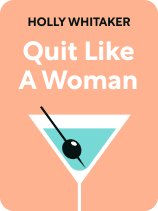

This article is an excerpt from the Shortform book guide to "Quit Like a Woman" by Holly Whitaker. Shortform has the world's best summaries and analyses of books you should be reading.
Like this article? Sign up for a free trial here.
Who is Holly Whitaker? What was her recovery from alcoholism like?
Holly Whitaker’s book Quit Like a Woman not only details how to give up alcohol, but provides a personal account of her own struggle with alcoholism. She takes readers all the way back to when she first started drinking to the day she went fully sober.
Read the inspiring story of Whitaker’s recovery so you can learn how to quit like a woman too.
Whitaker’s Denial of Her Alcoholism
To learn how to quit like a woman, we need to go back to Whitaker’s teenage years. Whitaker started drinking at age 13 and continued drinking throughout high school, which led to bad grades, a reputation as being sexually promiscuous, and low self-esteem. In college, she got her life back on track, but when she later started moving up the corporate ladder at a healthcare startup, her drinking, drug use, eating disorder, and spending spiraled out of control.
(Shortform note: Whitaker recounts her experiences as a young drinker, and many of the consequences she felt are seen in the broader population of underage drinkers. Beyond what Whitaker lists, underage drinkers also frequently have broken or unfulfilling relationships and are prone to violence. Further, heavy drinking at an early age is correlated with low self-esteem, depression, and other drug use—which we see in Whitaker’s later life, as well.)
Still, she was unwilling to admit that her drinking was a problem, justifying her continued consumption by comparing herself to friends who drank just as much and convincing herself she hadn’t passed the threshold of “alcoholic.” In fact, she dreaded the idea of being an alcoholic and having to give up fun—for her, drinking had become the only way to enjoy herself.
(Shortform note: Whitaker was displaying signs of denial through her years of adult drinking. Denial is a psychological defense mechanism wherein someone refuses to acknowledge an objective truth. The brain denies the truth because recognizing it would lead to anxiety and discomfort. This was certainly the case for Whitaker, for whom the idea of being “an alcoholic” would create extreme distress and alienate her from her normal activities and social groups.)
Whitaker’s Recognition of Her Alcoholism
However, over time, Whitaker began to despise her high-pressure, drink-heavy lifestyle and tried to get herself on track by meditating, eating well, and doing yoga—though, notably, not by giving up drinking. Then, one morning, she woke up hungover in her filthy apartment on a stained mattress without sheets and realized she couldn’t do this anymore. She realized the first step toward building a lifestyle she wanted was to stop drinking.
(Shortform note: For Whitaker, it was “hitting bottom” that morning in her bed that ended her denial. Hitting bottom is a relatively common concept in addiction and is often the event that forces someone to confront their problem. However, it doesn’t always require hitting rock bottom to break through denial: If you suspect you might have a problem with any addictive behavior, see a therapist or start noting when and how much of the addictive behavior you engage in—for instance, how many beers you have a night. Seeing this on paper makes it harder to deny the existence of a problem.)
Whitaker’s Quitting Alcohol
Whitaker quit drinking twice before doing so successfully. The first time, she quit because she became convinced she had Borderline Personality Disorder. This, to her, explained her struggle with alcohol and was a good reason to stop drinking. She stayed sober for eight weeks before drinking again. This started a period of binging and vacillating between drinking and being sober. She went sober again for two weeks and finally went fully sober on April 14, 2013.
(Shortform note: Whitaker’s denial of her alcoholism drove her to seek alternative solutions for her off-track life and emotions: yoga, meditation, and the diagnosis of Borderline Personality Disorder. It seems that while Whitaker was using an internal explanatory style—explaining events as being the result of her behavior and mindset, not as the result of environmental factors—she was finding the wrong internal explanations for her excessive drinking: stress and a disorder, rather than addiction.)

———End of Preview———
Like what you just read? Read the rest of the world's best book summary and analysis of Holly Whitaker's "Quit Like a Woman" at Shortform.
Here's what you'll find in our full Quit Like a Woman summary:
- Why society misunderstands what alcohol addiction is, what causes it, and how to treat it
- Why alcohol is always bad for you, even in moderation
- A feminine, holistic approach to recovery and sobriety






